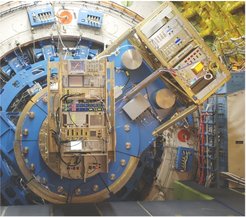GREAT - Our Far-Infrared Spectrometer Platform onboard of SOFIA
The German REceiver for Astronomy at Terahertz Frequencies (GREAT) is a heterodyne instrument platform for high-resolution far-infrared spectroscopy (λ/Δλ > ~107-8) on board of SOFIA, the Stratospheric Observatory for Infrared Astronomy.

Available channel-configurations and current performance parameters can be found in the "Fact Sheet".
GREAT detected first light on April 1st 2011, as one of two chosen instruments for SOFIA's basic science phase. A Special Feature of Astronomy & Astrophysics was published in May 2012 presenting the first science results of GREAT. Please follow the “Publications” link for a list of publications based on data obtained with GREAT.
Between April 2011 and August 2022, GREAT has conducted 240 flights, and was part of all southern deployments of SOFIA to Christchurch, New Zealand, as well as the deployments to Cologne, Germany, and Tahiti, French-Polynesia, during the COVID-19 pandemic. The “History” section shows an overview of notable events during GREAT’s lifetime.
GREAT is a Principle Investigator (PI) class instrument. This allows to continuously upgrade the instrument with the latest technologies available to the GREAT consortium.
| Principal Investigator (PI) | Bernd Klein | MPIfR |
|---|---|---|
| Co-PI | Heinz-Wilhelm Hübers | DLR-WR |
| Project Management |
Oliver Ricken
Urs Graf |
MPIfR
KOSMA |
- DLR-WR: Deutsches Zentrum für Luft- und Raumfahrt, Institut für Weltraumforschung, Berlin
- KOSMA: I. Physikalisches Institut, Universität zu Köln, Köln,
- MPIfR: Max-Planck-Institut für Radioastronomie, Bonn
The development of the instrument was financed by the participating institutes, the Max Planck Society and the German Research Foundation (Deutsche Forschungsgemeinschaft, DFG).
SOFIA – the Stratospheric Observatory for Infrared Astronomy
SOFIA is a joint project of NASA and DLR. More information on this unique observatory is provided by the Deutsches SOFIA Institut (DSI) and NASA.
Built into a Boeing 747-SP aircraft, a 2.5m diameter telescope is operated at flight altitudes of 12.5km and above. It thus enables scientific observations at far-infrared wavelengths that - due to the limited transmission of Earth's atmosphere at these wavelengths - are not possible from ground-based facilities.
